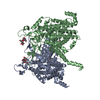+ Open data
Open data
- Basic information
Basic information
| Entry | Database: PDB / ID: 8wmq | |||||||||||||||||||||||||||||||||||||||||||||
|---|---|---|---|---|---|---|---|---|---|---|---|---|---|---|---|---|---|---|---|---|---|---|---|---|---|---|---|---|---|---|---|---|---|---|---|---|---|---|---|---|---|---|---|---|---|---|
| Title | trans-Zeatin bound state of Arabidopsis AZG1 at pH5.5 | |||||||||||||||||||||||||||||||||||||||||||||
 Components Components | Adenine/guanine permease AZG1 | |||||||||||||||||||||||||||||||||||||||||||||
 Keywords Keywords | TRANSPORT PROTEIN / cytokinin / transporter | |||||||||||||||||||||||||||||||||||||||||||||
| Function / homology |  Function and homology information Function and homology informationguanine transport / purine nucleobase transmembrane transporter activity / purine nucleobase transport / adenine transport / membrane / cytosol Similarity search - Function | |||||||||||||||||||||||||||||||||||||||||||||
| Biological species |  | |||||||||||||||||||||||||||||||||||||||||||||
| Method | ELECTRON MICROSCOPY / single particle reconstruction / cryo EM / Resolution: 3.3 Å | |||||||||||||||||||||||||||||||||||||||||||||
 Authors Authors | Xu, L. / Guo, J. | |||||||||||||||||||||||||||||||||||||||||||||
| Funding support |  China, 3items China, 3items
| |||||||||||||||||||||||||||||||||||||||||||||
 Citation Citation |  Journal: Nat Plants / Year: 2024 Journal: Nat Plants / Year: 2024Title: Structures and mechanisms of the Arabidopsis cytokinin transporter AZG1. Authors: Lingyi Xu / Wei Jia / Xin Tao / Fan Ye / Yan Zhang / Zhong Jie Ding / Shao Jian Zheng / Shuai Qiao / Nannan Su / Yu Zhang / Shan Wu / Jiangtao Guo /  Abstract: Cytokinins are essential for plant growth and development, and their tissue distributions are regulated by transmembrane transport. Recent studies have revealed that members of the 'Aza-Guanine ...Cytokinins are essential for plant growth and development, and their tissue distributions are regulated by transmembrane transport. Recent studies have revealed that members of the 'Aza-Guanine Resistant' (AZG) protein family from Arabidopsis thaliana can mediate cytokinin uptake in roots. Here we present 2.7 to 3.3 Å cryo-electron microscopy structures of Arabidopsis AZG1 in the apo state and in complex with its substrates trans-zeatin (tZ), 6-benzyleaminopurine (6-BAP) or kinetin. AZG1 forms a homodimer and each subunit shares a similar topology and domain arrangement with the proteins of the nucleobase/ascorbate transporter (NAT) family. These structures, along with functional analyses, reveal the molecular basis for cytokinin recognition. Comparison of the AZG1 structures determined in inward-facing conformations and predicted by AlphaFold2 in the occluded conformation allowed us to propose that AZG1 may carry cytokinins across the membrane through an elevator mechanism. | |||||||||||||||||||||||||||||||||||||||||||||
| History |
|
- Structure visualization
Structure visualization
| Structure viewer | Molecule:  Molmil Molmil Jmol/JSmol Jmol/JSmol |
|---|
- Downloads & links
Downloads & links
- Download
Download
| PDBx/mmCIF format |  8wmq.cif.gz 8wmq.cif.gz | 348.3 KB | Display |  PDBx/mmCIF format PDBx/mmCIF format |
|---|---|---|---|---|
| PDB format |  pdb8wmq.ent.gz pdb8wmq.ent.gz | 284.5 KB | Display |  PDB format PDB format |
| PDBx/mmJSON format |  8wmq.json.gz 8wmq.json.gz | Tree view |  PDBx/mmJSON format PDBx/mmJSON format | |
| Others |  Other downloads Other downloads |
-Validation report
| Summary document |  8wmq_validation.pdf.gz 8wmq_validation.pdf.gz | 1.4 MB | Display |  wwPDB validaton report wwPDB validaton report |
|---|---|---|---|---|
| Full document |  8wmq_full_validation.pdf.gz 8wmq_full_validation.pdf.gz | 1.5 MB | Display | |
| Data in XML |  8wmq_validation.xml.gz 8wmq_validation.xml.gz | 39.3 KB | Display | |
| Data in CIF |  8wmq_validation.cif.gz 8wmq_validation.cif.gz | 57.8 KB | Display | |
| Arichive directory |  https://data.pdbj.org/pub/pdb/validation_reports/wm/8wmq https://data.pdbj.org/pub/pdb/validation_reports/wm/8wmq ftp://data.pdbj.org/pub/pdb/validation_reports/wm/8wmq ftp://data.pdbj.org/pub/pdb/validation_reports/wm/8wmq | HTTPS FTP |
-Related structure data
| Related structure data |  37658MC  8irlC  8irmC  8irnC  8iroC  8irpC  8wo7C M: map data used to model this data C: citing same article ( |
|---|---|
| Similar structure data | Similarity search - Function & homology  F&H Search F&H Search |
- Links
Links
- Assembly
Assembly
| Deposited unit | 
|
|---|---|
| 1 |
|
- Components
Components
| #1: Protein | Mass: 65686.703 Da / Num. of mol.: 2 Source method: isolated from a genetically manipulated source Source: (gene. exp.)   Homo sapiens (human) / References: UniProt: Q9SRK7 Homo sapiens (human) / References: UniProt: Q9SRK7#2: Polysaccharide | Source method: isolated from a genetically manipulated source #3: Chemical | Has ligand of interest | Y | Has protein modification | Y | |
|---|
-Experimental details
-Experiment
| Experiment | Method: ELECTRON MICROSCOPY |
|---|---|
| EM experiment | Aggregation state: PARTICLE / 3D reconstruction method: single particle reconstruction |
- Sample preparation
Sample preparation
| Component | Name: complex of AZG1 and trans-zeatin / Type: COMPLEX / Entity ID: #1 / Source: RECOMBINANT |
|---|---|
| Molecular weight | Value: 0.1312 MDa / Experimental value: NO |
| Source (natural) | Organism:  |
| Source (recombinant) | Organism:  Homo sapiens (human) Homo sapiens (human) |
| Buffer solution | pH: 5.5 |
| Specimen | Embedding applied: NO / Shadowing applied: NO / Staining applied: NO / Vitrification applied: YES |
| Vitrification | Cryogen name: ETHANE |
- Electron microscopy imaging
Electron microscopy imaging
| Experimental equipment |  Model: Titan Krios / Image courtesy: FEI Company |
|---|---|
| Microscopy | Model: FEI TITAN KRIOS |
| Electron gun | Electron source:  FIELD EMISSION GUN / Accelerating voltage: 300 kV / Illumination mode: OTHER FIELD EMISSION GUN / Accelerating voltage: 300 kV / Illumination mode: OTHER |
| Electron lens | Mode: BRIGHT FIELD / Nominal defocus max: 1600 nm / Nominal defocus min: 800 nm |
| Image recording | Electron dose: 54 e/Å2 / Film or detector model: GATAN K3 BIOQUANTUM (6k x 4k) |
- Processing
Processing
| EM software | Name: PHENIX / Category: model refinement | ||||||||||||||||||||||||
|---|---|---|---|---|---|---|---|---|---|---|---|---|---|---|---|---|---|---|---|---|---|---|---|---|---|
| CTF correction | Type: PHASE FLIPPING AND AMPLITUDE CORRECTION | ||||||||||||||||||||||||
| 3D reconstruction | Resolution: 3.3 Å / Resolution method: FSC 0.143 CUT-OFF / Num. of particles: 71039 / Symmetry type: POINT | ||||||||||||||||||||||||
| Refine LS restraints |
|
 Movie
Movie Controller
Controller









 PDBj
PDBj

